The 1907/15 Mors Le Sanglier - Aero Gp Special
By: Ab Jenkins (yes, it's written in the 3rd person folks, it's fun)
<<<--- back

Winter, 2020-21.
The cold & covid feared months were the worst. All the time spent indoors, so much time to consume in a newer and isolated reality while the world went into an odd kind of chaos.
The time in that cold carport in Utah saw the birth of the sky... wait, light? I have no idea what color blue that really is.
Rust-monster.

Just when I thought he was happy with a small fleet of cyclekarts, this "Scraptor" gets the idea to build another. (Ask Johnny Dumfries what that snazzy nickname means one day. He actually calls Kelly other names too, it's rather funny I think.)
He originally just wanted a normal cyclekart with NORMAL front leaf springs as his prior jalopy's all used quarter eliptics and transverse jobs. He was looking for a normal build.
But no.
Christ no. He chooses something hard to build.
That resourceful curse hadn't run its course yet.
I swear, he does it to amuse himself because he's bored.
MORS is the Latin word for death, a coincidence which did not escape notice of one motorphobe Member of Parliament in the early 1900's.
The man claimed the name implied that Mors drivers had the licence to kill anyone who crossed the path of their cars.
Sadly, it did happen... not on purpose of course. But yes, a child was struck by a Mors driver during an early race who later died.
The Mors automobile factory was an early French car manufacturer. It was one of the first to take part in automobile racing in 1897. By the turn of the century, automobile racing had become largely a contest between Mors and Panhard et Levassor... a part of history rarely mentioned.
Mors was also one of the first automobiles to use the V engine configuration... another tidbit to add to that mental thicket.
Chew on that American car guy.
The company produced a number of models which were sold widely in Europe and in the USA. In 1905 these ranged from 2.3 litres to the 8.1 litre 40/52 HP and by 1914 Minerva-built Knight sleeve valve engines. Their efforts in racing ended with World War I and attempts to return were never realized.
Mors, was the basis of what is now, Citroën. André Citroën took over at Mors when they went under and turned it around. The Mors name was axed, so in truth... the mors really lives on to this very day.
During the company's height, average business-clown purchased the rolling chasis seen below. Then, cleverly, the company sent you packing to a service facility where... they'd put any body you fancied on the thing. These ranged from the sedan to the "People mover," or bus.

Very few Mors automobiles survive to this day.
The Mors Le Sanglier is a grand prix special powered by an American 1915 8.2 litre OX5 Curtis Aircraft V8 Engine which came standard in a Curtiss JN-4D Jenny.
The Curtiss Jenny was the first mass-produced American aircraft. In 1917, the U.S. did not have aircraft capable of fighting in the skies over France. Most American planes were designed for sport, not war. While American aviation engineers were attempting to catch up, many adventurous young men were eager to become military pilots. The vast majority of U.S. and Canadian pilots in World War I trained in Jennys, even though the plane itself never saw combat.
The body work, and the rest of the car making it a "special" was created by Oliver Way Design, and driven by Niall Dyer, the Caretaker. It appears the overall car is hommage to the Knight-sleeve technology, thus, the bonnet appearing as a big scary knight. That's only a guess however. We couldn't find Ollie to ask.
Like most Edwardian cars, it's a large beast. Seen below with many others at Goodwood, she holds her place among monsters.

She is a daily driver capable of 100 mph and the only brakes on the car are in the back, and they don't work well... quoted Niall Dyer in an email exchange between himself & Kelly.
Currently, it still uses the same base chassis sold in 1906 and forward from (probably) a four seater sedan she once was. Over the years, one can see it was braced once or twice. It is bent and sagging... Just like any charmer of this age.
It started as the usual sketches as Kelly does... planning the car out as he went on lunch break. Sure, creating a car like this could take all kinds of routes, but in his mind... The trick here was to create the running gear AND have the outer gearing actually drive the car... then sit on the entire spinning nightmare.
... and if one was going to build a car like this, "Punting" simply will not do.









Seeing the build was following the Edwardian exception, (something most modern and new cyclekarters won't touch because it's not sleek).. 18" wheels were in order. It had to be bigger than the average cyclekart, yet look right if next to one. A trip to the local (and last) motorcycle junkyard in the area turned up enough to get the project off the ground. (see what I did there?)

Two of the fronts were fitted with some lathed down asuza hubs, then coupled to the wheel hubs in a mish-mash sort of fashion to act as rears and the others happen to take the same bearing used on Honda Trail 90 wheels.
Sketch after sketch, it came alive as the bits were collected & scavenged. Once the basic bits were collected, some new, some rusty used parts... it was laid it out.

First up was the the drivetrain carriage. It actually was started on the Living room floor one morning with coffee in hand, fuzzy slippers and watching re-runs of Animaniacs.

The first rendition failed miserably too. After a couple weeks, another design presented itself and became reality. It relied on being bolted to the frame for strength.

Next up... commit murder. Wipe out a 1963 Chevy truck hood. The idea came at lunch one day driving around when he said he saw a similar rusty truck on the street, covered in snow... then turned his head sideways.
Really?
Yep. Once he visualizes what he's doin... pure dumb luck will have him stumbling upon it in short order.
It's a curse, and he knows it.
Trust me, I know he'd rather destroy a Ford at will, but FAR higher quality parts were in order.
Still in the cold, he sliced up the hood in his driveway, carefully tracing out the front bonnet from memory.

Pretty sure my dog pissed on it right there...

Murderer.
Next it was onto some other items that were needed. The rear of the real car, has this big ass gas tank in the back that oddly resembled a mailbox.
Who'd imagine stealing it from some country road would be so...
..... I'm kidding.
Why does an old mailbox cost so much? Why? He said.
One hesitant eBay purchase later...
Next up was to take over his entire living room in the middle of winter to mock up the thing.
And that he did.

The front axle was next. To achieve it, there was a plan but doing it properly wasn't quite in order.
So one scrounges... and scrounge one does, again.
A spare junk trailer had just the thing. The cross members had the same basic bends as the front axle.
Then it all came together. Time go get outside to freeze... and start making it a reality.





















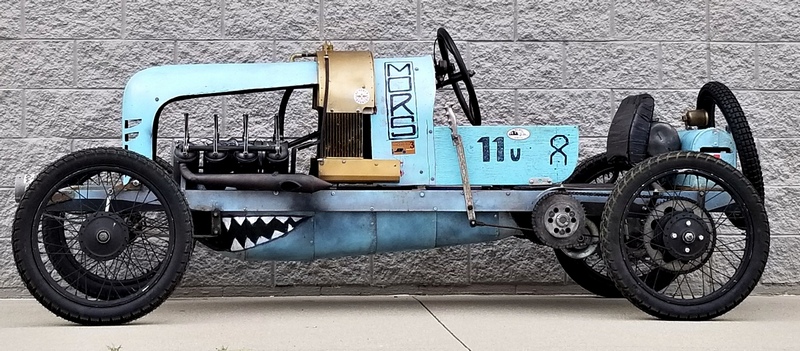
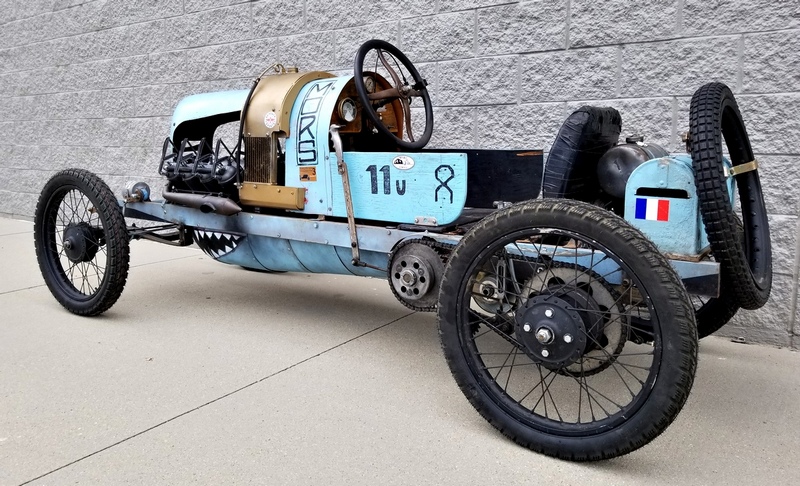
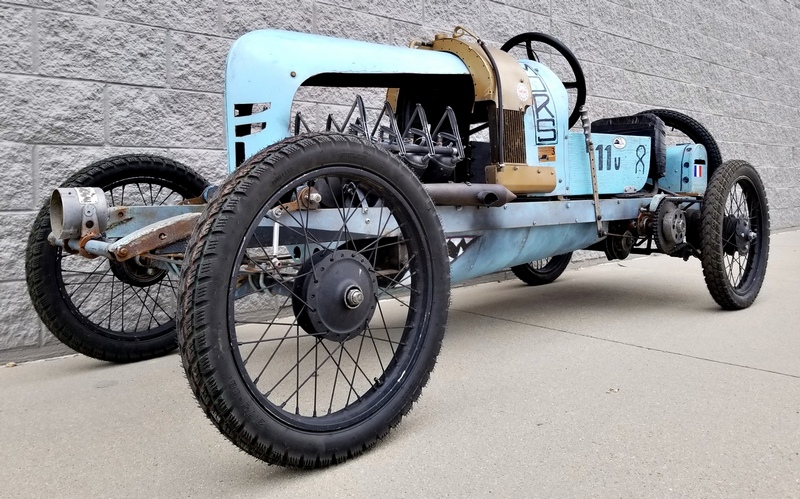
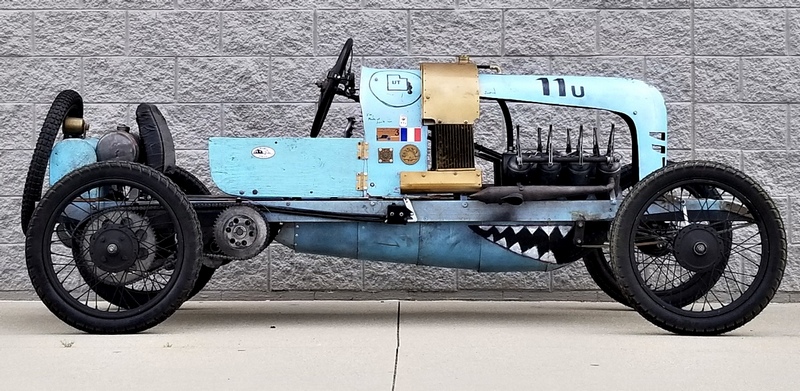
Known Pilots:
Kelly Wood, Zach Smith, Miranda Smith, Dustin Greenleaf, David Dupaquier
The parts:
- Front body/bonnet, a sliced up 1963 Chevy Truck hood front & right corners, then stood on end and coupled.
- Rear bonnet/sides & dash wrap around, 1/3 of a barrel that once contained Honey. Slicing it up smelled like cooking marshmallows over a fire. (probably a scent of her future adventures?)
- Front light, aluminum air cleaner housing from a tractor. Mounts for the light are 2 - 1" locking collars welded to pieces of cut up go kart pedals. (Manco)
- Leaf springs, 2 main springs from rusty trailer. All leaves discarded but the main ones. Were 2" wide, sliced off 1/4" from each side making 1.5 in springs.
- Front suspension shackles, from the same trailer.
- Rear compartment, is a real mailbox
- Wheels, late 60's Yamaha LS2 100 Front Rims. 18" x 1.40 rims. These wheels are also found on Yamaha models: LT2, DT100, AT1, CT1, HT1, TY175, CT3, MX100, TTR125 and CT2 as well.Tires on original rolling rendition (and Raced at the Huntsville GP 2) were on the wheels when found in junkyard. They were patched but one leaked slowly. :(
- Steering, single rod from colum to right spindle, solid bar from right spindle to left. 3 steering columns welded together with tubes inside, then outer couplings as well.
- Front axle, a spliced together version of the original. Is made of the pre-bent cross members from an old trailer. The bend in the cross members matched the mors front axle geometry perfectly.
- Seat, from a go cart/dune buggy found in a dumpster during neighborhood clean up program. (It's called Dumpster Diving)
- Radiator assembly, 2 trashed JR Rotax race kart radiators cut, then aluminum sheets cut & bent to create the entire system. The Rotax radiators were his Daughters Idea when he got "writers block" one day and she came up with the idea in seconds.
- Braking system, left hand lever to vintage mechanical disc. It kind of... slows the car down but does function. When it's hot, will lock up the rear end. Just remember that the brake, is your left hand.
- Primary brake, right foot to MCP 7.75 Hydraulic Disc
- Underbelly, a rusty barrel sliced into sections, then riveted in place to acheive the look (also resembles a roly-poly bug... "potato bug" for you westerners...)
- Front underbelly, an old motorcycle gas tank cut, bent, then riveted to the barrel assembly.
- Floor is modular, comes out of the car entirely, with storage underneath the floorboard, in the belly.
- inner framework items: (e.g. floor frame, steering hoop, gas tank perch, etc... made of bed frames.
- Left side body, crappy piece of wood
- Right side body, same thing, but is actually a door that opens so you don't have to climb into it.
- Steering wheel, rusty Ford Model T.
- Main Frame rails, 1x3, 1/16th wall steel, common to most cyclekarts
- cross beams, 1" steel tubing up front and extra 1x3 pieces
- Peerless Differential from a lawn tractor, different shafts were placed inside which were vintage and longer from a trashed differential spare unit who's case had cracked.
- Outer center drive axle adornments (the things with 6 holes in them) were sliced Manco Go kart rear rim halves coupled to laser cut inserts to achieve the look. Originally created to achieve Go-Power vintage knockoffs in the vintage karting realm. They were of Kelly's own design, only 8 exist. They are decorative only, however serve a purpose by keeping from cutting too much of the center axle off. (also serves as a conversation piece when average joe can't quite figure out if they're actually go kart clutches.)
- Sprocket / Drive hubs were custom made for the huge rear sprockets.
- Sprockets: 3 - 48 tooth, 2 - 16 tooth, 1 -10 tooth and dual 66 T's in the back. Ratio is about 6.625:1
- Petrol Tank, vintage Kohler farm implement, 3/4 gallon.
- Front spindles, asuza 3/4"
- 14 - 1" locking axle collars
- Air cleaner assembly: 1 - 2" rubber plumbing elbow pointed downwards coupled to a vintage Briggs air filter cup. It points down so it can be driven in any weather and never suck up water.
- Muffler, drilled out vintage Briggs and a metal elbow or two. Being under the car, tends to have a beefier sound if you're on the gas as it echos under there.
- Left side braking handle, the control handle from a 1957 Mercury outboard motor known as the "Dockbuster."
- Dash Adornments: A bunch of bullshit gauges & knobs that do nothing.
- Faux engine: Pvc pipes, plastic springs from spiral notebooks, finishing washers, the pipes are made of plastic baseball bats heated & bent, and the valve rockers.. are made of plastic knives. Yep.
Car Specs:
Width: Rear/Fixed: 39" Front/Adjustable from 38" to 40"
Wheelbase: 79"
Tires: Front 18" x 2.75, Rear 18" x 3.0
Weight: 291 Lbs. (STILL, lighter than today's average build)
Engine: Predator 212, Hemi version, ungoverned.
Clearance: nearly 1 foot. The car can drive through/over small streams, mud, logs and other cars easily.
Tav: Some cheap chinese unit.
Chains: #420 (skinny) on the Tav, Dual #40's industrial outer.
Known Top Speed: 45 mph
In total, there are 15 bearings in the cars drive/rolling systems. Normal cyclekarts use 6.
Drivetrain Details:
The entire rear drive system in the car is modular, 4 bolts and the entire drivetrain, engine, wheels and all, come right off the car in a u-shaped carriage of sorts. The carriage, can also pivot on only the front bolts and with the addition of 2 removable springs, has a small limited bit of rear suspension but hasn't been deployed yet.
Path of drivetrain:
- Motor to Tav, #41 chain, 10 T to 48 T on center drive Differential under the seat.
- Differential out the sides, Twin 48T gears with heavier #40 chains actually drive the car. Rear gears are 66T.
- Heavier chain wasn't necessary but was used to achieve the look of the car.
- Left & right Tensioner device, allows for removal of the chain without removing a wheel. Tensioning device is rigid via locking turnbuckle allowing also for quick gearing changes on the outer front drive.
- Both rear wheels drive the car. Right wheel is keyed to the axle as is the right sprocket. Left wheel & sprocket are one unit that free spin on one outer 3/4" bearing on the outer hub, and greased wheel drive hub. This achieved full differential action and drive. If the left is keyed, becomes fully keyed system. There is also a planned pin that can lock up the diff under the seat compartment flip up hatch... thus, dual keyed.
- Differential and rear axle can drop out the bottom of the carriage, was created with this in mind. Bearing carriers were welded upside down for this purpose encase, for some oddball reason one had to actually do it.
The rear carriage & drive system accounts for nearly 50% of the car's weight.
The car's first event was the Huntsville Grand Prix II where she stood among 46 other cyclekarts from all over the United states. She wasn't entirely complete at that time but watching her go, as she did in one main heat starting at Position 12...
... 5 laps later, she took the checkered flag.
Since the initial build, fellow artist & friend Samuel Baird was given the car to do something he does quite well. While Kelly can do it, we often help each other out. Seeing this car was built in tandem with Sam's Thunderbug, Sam got to do his fantastic job of making her look old.
All of that, put her in the top level of any cyclekart build.
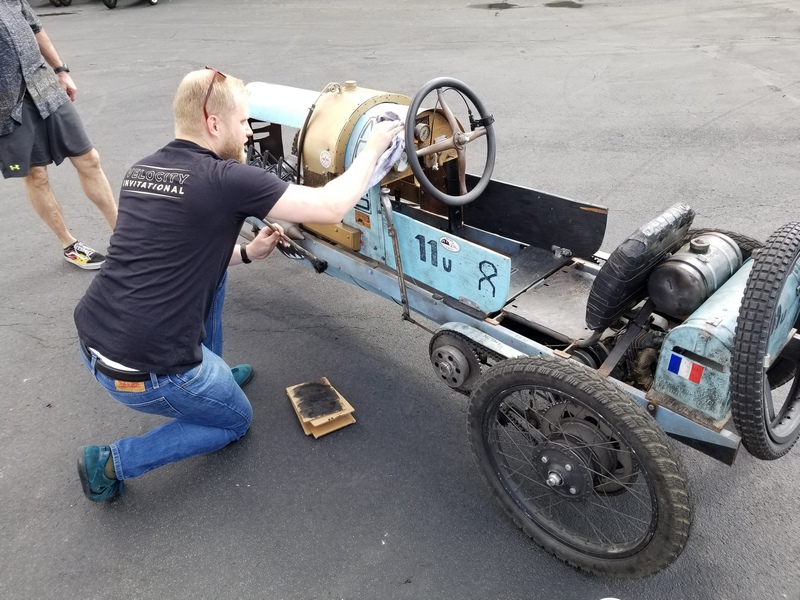
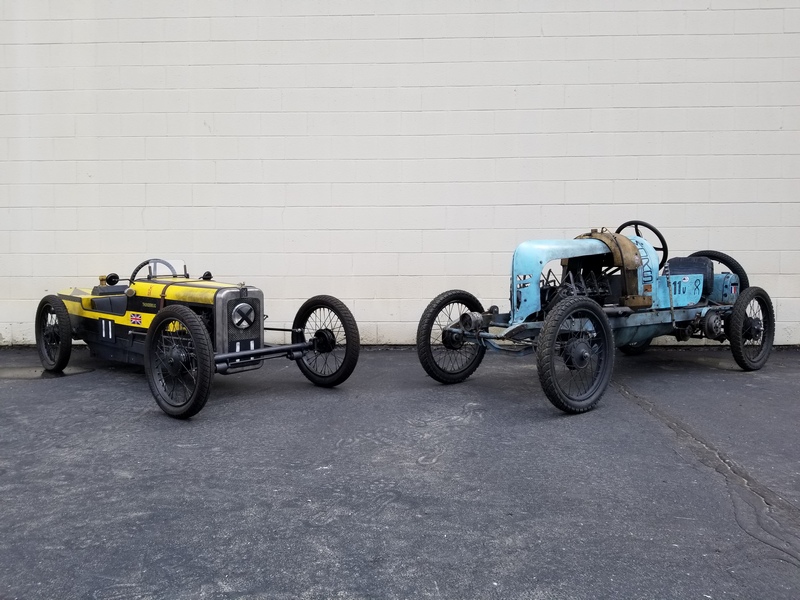
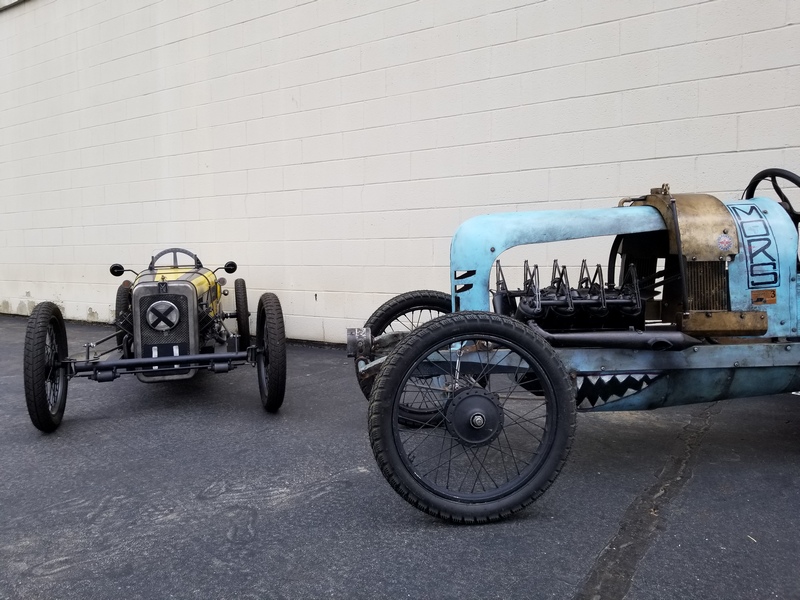
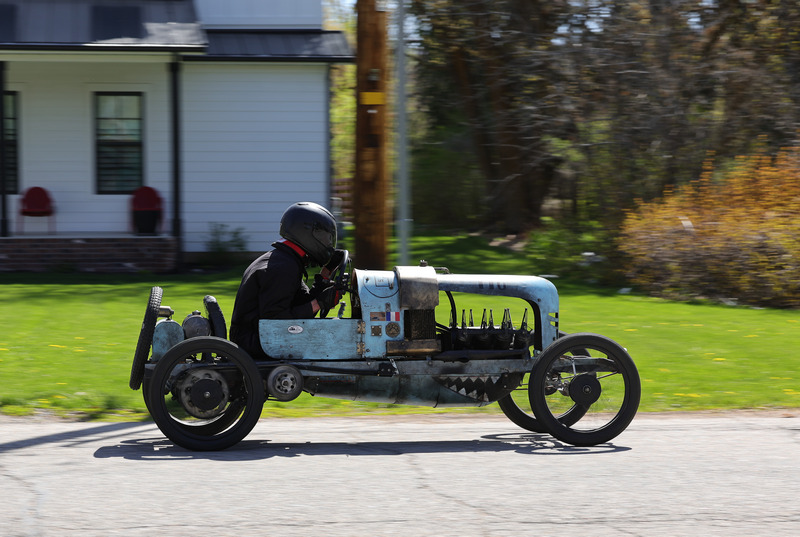
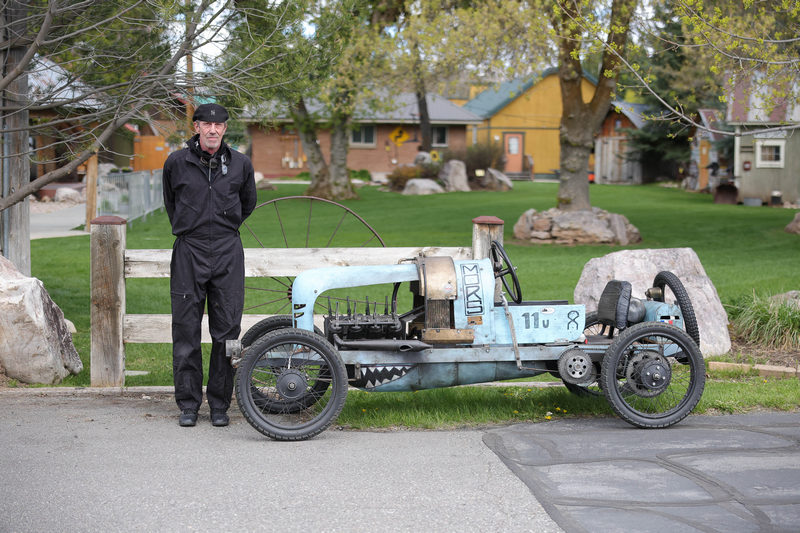
Along with her running mate and sporting the same number 11, both look just grand running side by side. (these two are of the rare "COVID Era" Cyclekarts. They were born, and run, during Covid.)
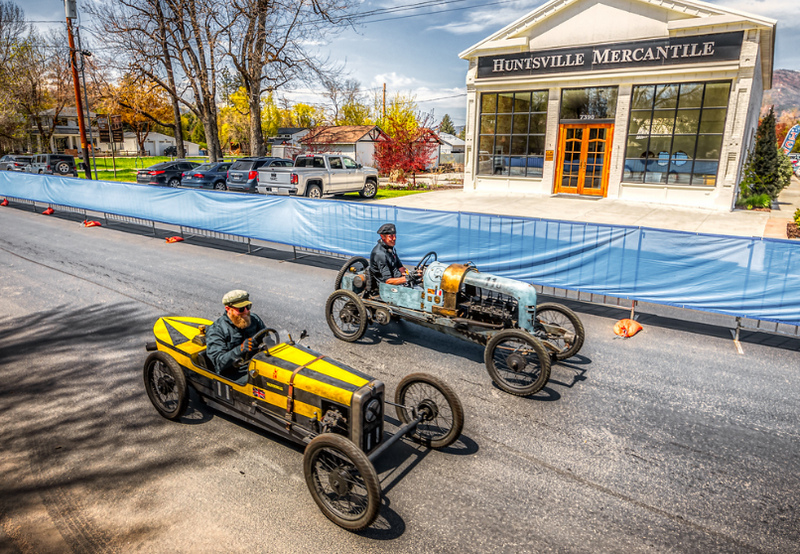
In the end, one can see that the CK does not need to be overbuilt. As elaborate as the drivetrain is, She's not broken anything yet, other than a flat tire in 3+ years.
Ab Jenkins
<<<--- back
| |